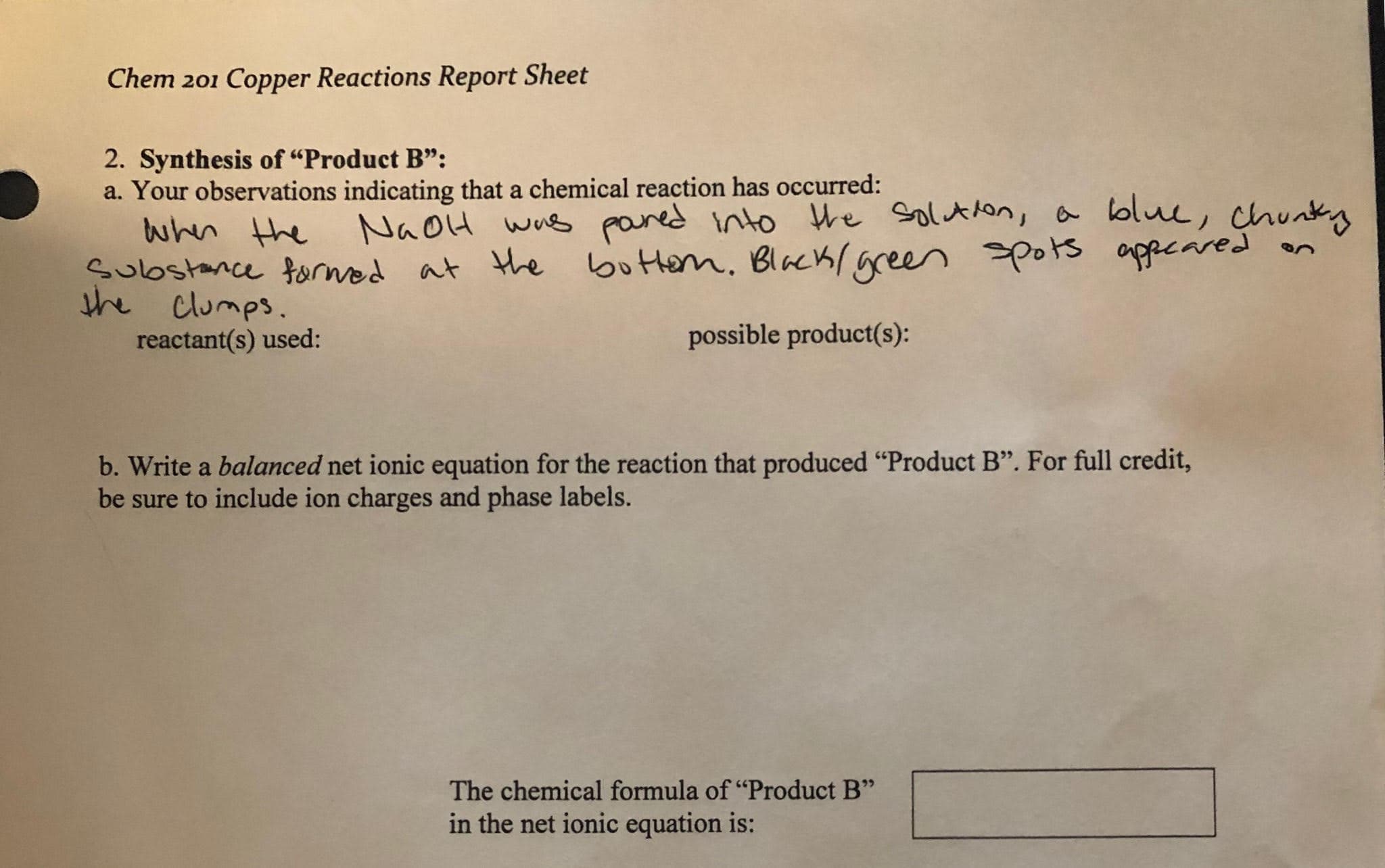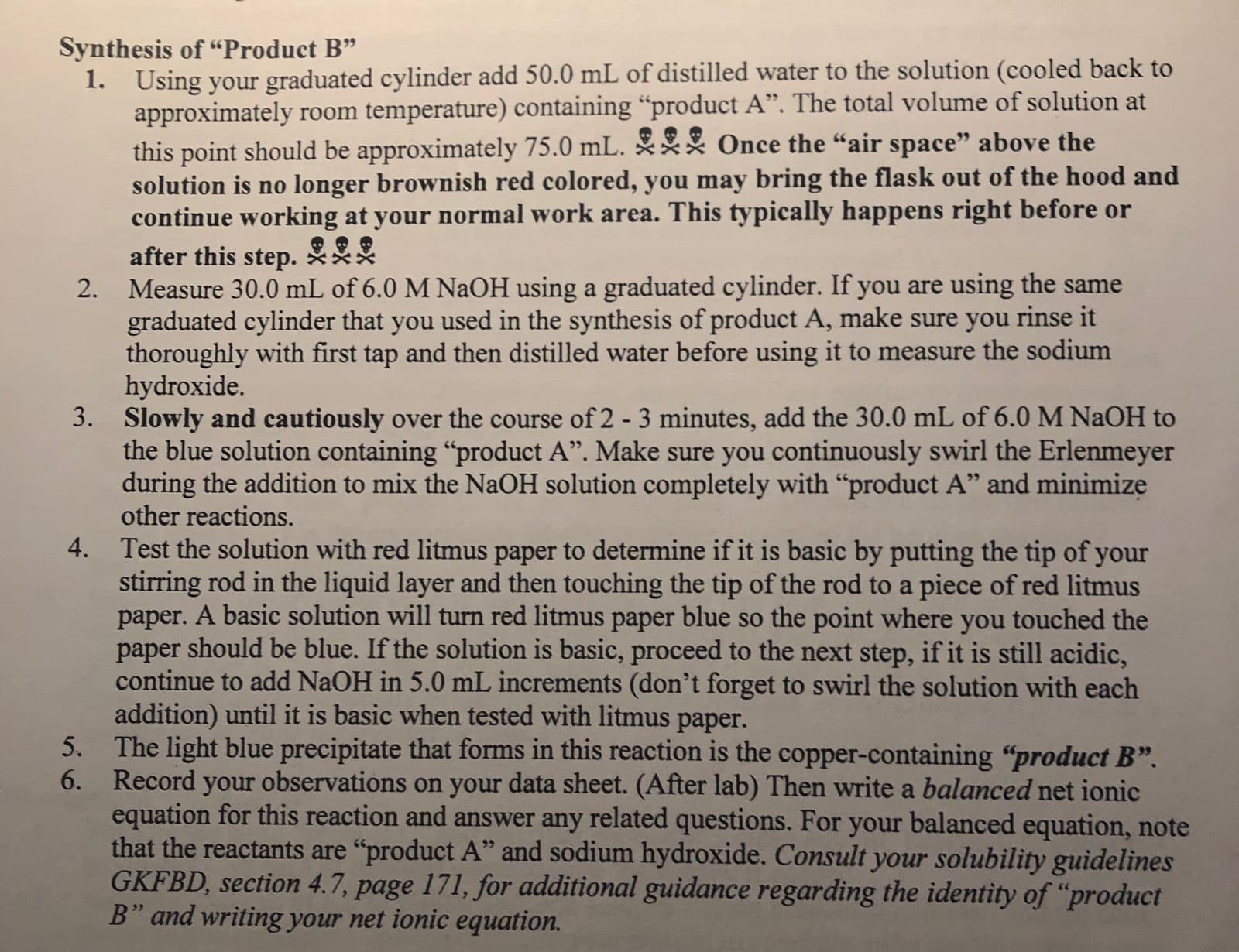Chem 201 Copper Reactions Report Sheet 2. Synthesis of "Product B": a. Your observations indicating that a chemical reaction has occurred: lolu, chunky wus pared nto We Solt tan the Naou oppeared sHem. Bchgreen pors apperes Sulostance ormed at e he clumps. possible product(s): reactant(s) used: b. Write a balanced net ionic equation for the reaction that produced "Product B". For full credit, be sure to include ion charges and phase labels. The chemical formula of "Product B" in the net ionic equation is: Synthesis of "Product B" 1. Using your graduated cylinder add 50.0 mL of distilled water to the solution (cooled back to approximately room temperature) containing "product A". The total volume of solution at this point should be approximately 75.0 mL. % Once the "air space" above the solution is no longer brownish red colored, you may bring the flask out of the hood and continue working at your normal work area. This typically happens right before or after this step. 2. Measure 30.0 mL of 6.0 M NaOH using a graduated cylinder. If you are using the same graduated cylinder that you used in the synthesis of product A, make sure you rinse it thoroughly with first tap and then distilled water before using it to measure the sodium hydroxide. 3. Slowly and cautiously over the course of 2 - 3 minutes, add the 30.0 mL of 6.0 M NaOH to the blue solution containing "product A". Make sure you continuously swirl the Erlenmeyer during the addition to mix the NAOH solution completely with "product A" and minimize other reactions. 4. Test the solution with red litmus paper to determine if it is basic by putting the tip of your stirring rod in the liquid layer and then touching the tip of the rod to a piece of red litmus paper. A basic solution will turn red litmus paper blue so the point where you touched the paper should be blue. If the solution is basic, proceed to the next step, if it is still acidic, continue to add NAOH in 5.0 mL increments (don't forget to swirl the solution with each addition) until it is basic when tested with litmus paper. 5. The light blue precipitate that forms in this reaction is the copper-containing "product B". 6. Record your observations on your data sheet. (After lab) Then write a balanced net ionic equation for this reaction and answer any related questions. For your balanced equation, note that the reactants are "product A" and sodium hydroxide. Consult your solubility guidelines GKFBD, section 4.7, page 171, for additional guidance regarding the identity of "product B" and writing your net ionic equation.
Chem 201 Copper Reactions Report Sheet 2. Synthesis of "Product B": a. Your observations indicating that a chemical reaction has occurred: lolu, chunky wus pared nto We Solt tan the Naou oppeared sHem. Bchgreen pors apperes Sulostance ormed at e he clumps. possible product(s): reactant(s) used: b. Write a balanced net ionic equation for the reaction that produced "Product B". For full credit, be sure to include ion charges and phase labels. The chemical formula of "Product B" in the net ionic equation is: Synthesis of "Product B" 1. Using your graduated cylinder add 50.0 mL of distilled water to the solution (cooled back to approximately room temperature) containing "product A". The total volume of solution at this point should be approximately 75.0 mL. % Once the "air space" above the solution is no longer brownish red colored, you may bring the flask out of the hood and continue working at your normal work area. This typically happens right before or after this step. 2. Measure 30.0 mL of 6.0 M NaOH using a graduated cylinder. If you are using the same graduated cylinder that you used in the synthesis of product A, make sure you rinse it thoroughly with first tap and then distilled water before using it to measure the sodium hydroxide. 3. Slowly and cautiously over the course of 2 - 3 minutes, add the 30.0 mL of 6.0 M NaOH to the blue solution containing "product A". Make sure you continuously swirl the Erlenmeyer during the addition to mix the NAOH solution completely with "product A" and minimize other reactions. 4. Test the solution with red litmus paper to determine if it is basic by putting the tip of your stirring rod in the liquid layer and then touching the tip of the rod to a piece of red litmus paper. A basic solution will turn red litmus paper blue so the point where you touched the paper should be blue. If the solution is basic, proceed to the next step, if it is still acidic, continue to add NAOH in 5.0 mL increments (don't forget to swirl the solution with each addition) until it is basic when tested with litmus paper. 5. The light blue precipitate that forms in this reaction is the copper-containing "product B". 6. Record your observations on your data sheet. (After lab) Then write a balanced net ionic equation for this reaction and answer any related questions. For your balanced equation, note that the reactants are "product A" and sodium hydroxide. Consult your solubility guidelines GKFBD, section 4.7, page 171, for additional guidance regarding the identity of "product B" and writing your net ionic equation.
Chemical Principles in the Laboratory
11th Edition
ISBN:9781305264434
Author:Emil Slowinski, Wayne C. Wolsey, Robert Rossi
Publisher:Emil Slowinski, Wayne C. Wolsey, Robert Rossi
Chapter35: Spot Tests For Some Common Anions
Section: Chapter Questions
Problem 3ASA
Related questions
Question
For this chemistry problem, I am stuck on what the reactants and products are in order to determine the net ionic equation.
Thanks much.

Transcribed Image Text:Chem 201 Copper Reactions Report Sheet
2. Synthesis of "Product B":
a. Your observations indicating that a chemical reaction has occurred:
lolu, chunky
wus pared nto We Solt tan
the Naou
oppeared
sHem. Bchgreen pors apperes
Sulostance ormed at e
he clumps.
possible product(s):
reactant(s) used:
b. Write a balanced net ionic equation for the reaction that produced "Product B". For full credit,
be sure to include ion charges and phase labels.
The chemical formula of "Product B"
in the net ionic equation is:

Transcribed Image Text:Synthesis of "Product B"
1. Using your graduated cylinder add 50.0 mL of distilled water to the solution (cooled back to
approximately room temperature) containing "product A". The total volume of solution at
this point should be approximately 75.0 mL. % Once the "air space" above the
solution is no longer brownish red colored, you may bring the flask out of the hood and
continue working at your normal work area. This typically happens right before or
after this step.
2. Measure 30.0 mL of 6.0 M NaOH using a graduated cylinder. If you are using the same
graduated cylinder that you used in the synthesis of product A, make sure you rinse it
thoroughly with first tap and then distilled water before using it to measure the sodium
hydroxide.
3. Slowly and cautiously over the course of 2 - 3 minutes, add the 30.0 mL of 6.0 M NaOH to
the blue solution containing "product A". Make sure you continuously swirl the Erlenmeyer
during the addition to mix the NAOH solution completely with "product A" and minimize
other reactions.
4. Test the solution with red litmus paper to determine if it is basic by putting the tip of your
stirring rod in the liquid layer and then touching the tip of the rod to a piece of red litmus
paper. A basic solution will turn red litmus paper blue so the point where you touched the
paper should be blue. If the solution is basic, proceed to the next step, if it is still acidic,
continue to add NAOH in 5.0 mL increments (don't forget to swirl the solution with each
addition) until it is basic when tested with litmus paper.
5. The light blue precipitate that forms in this reaction is the copper-containing "product B".
6. Record your observations on your data sheet. (After lab) Then write a balanced net ionic
equation for this reaction and answer any related questions. For your balanced equation, note
that the reactants are "product A" and sodium hydroxide. Consult your solubility guidelines
GKFBD, section 4.7, page 171, for additional guidance regarding the identity of "product
B" and writing your net ionic equation.
Expert Solution
This question has been solved!
Explore an expertly crafted, step-by-step solution for a thorough understanding of key concepts.
This is a popular solution!
Trending now
This is a popular solution!
Step by step
Solved in 2 steps with 2 images

Knowledge Booster
Learn more about
Need a deep-dive on the concept behind this application? Look no further. Learn more about this topic, chemistry and related others by exploring similar questions and additional content below.Recommended textbooks for you

Chemical Principles in the Laboratory
Chemistry
ISBN:
9781305264434
Author:
Emil Slowinski, Wayne C. Wolsey, Robert Rossi
Publisher:
Brooks Cole

Chemistry: An Atoms First Approach
Chemistry
ISBN:
9781305079243
Author:
Steven S. Zumdahl, Susan A. Zumdahl
Publisher:
Cengage Learning

Introductory Chemistry: A Foundation
Chemistry
ISBN:
9781337399425
Author:
Steven S. Zumdahl, Donald J. DeCoste
Publisher:
Cengage Learning

Chemical Principles in the Laboratory
Chemistry
ISBN:
9781305264434
Author:
Emil Slowinski, Wayne C. Wolsey, Robert Rossi
Publisher:
Brooks Cole

Chemistry: An Atoms First Approach
Chemistry
ISBN:
9781305079243
Author:
Steven S. Zumdahl, Susan A. Zumdahl
Publisher:
Cengage Learning

Introductory Chemistry: A Foundation
Chemistry
ISBN:
9781337399425
Author:
Steven S. Zumdahl, Donald J. DeCoste
Publisher:
Cengage Learning

Chemistry by OpenStax (2015-05-04)
Chemistry
ISBN:
9781938168390
Author:
Klaus Theopold, Richard H Langley, Paul Flowers, William R. Robinson, Mark Blaser
Publisher:
OpenStax

Chemistry & Chemical Reactivity
Chemistry
ISBN:
9781337399074
Author:
John C. Kotz, Paul M. Treichel, John Townsend, David Treichel
Publisher:
Cengage Learning

Chemistry & Chemical Reactivity
Chemistry
ISBN:
9781133949640
Author:
John C. Kotz, Paul M. Treichel, John Townsend, David Treichel
Publisher:
Cengage Learning